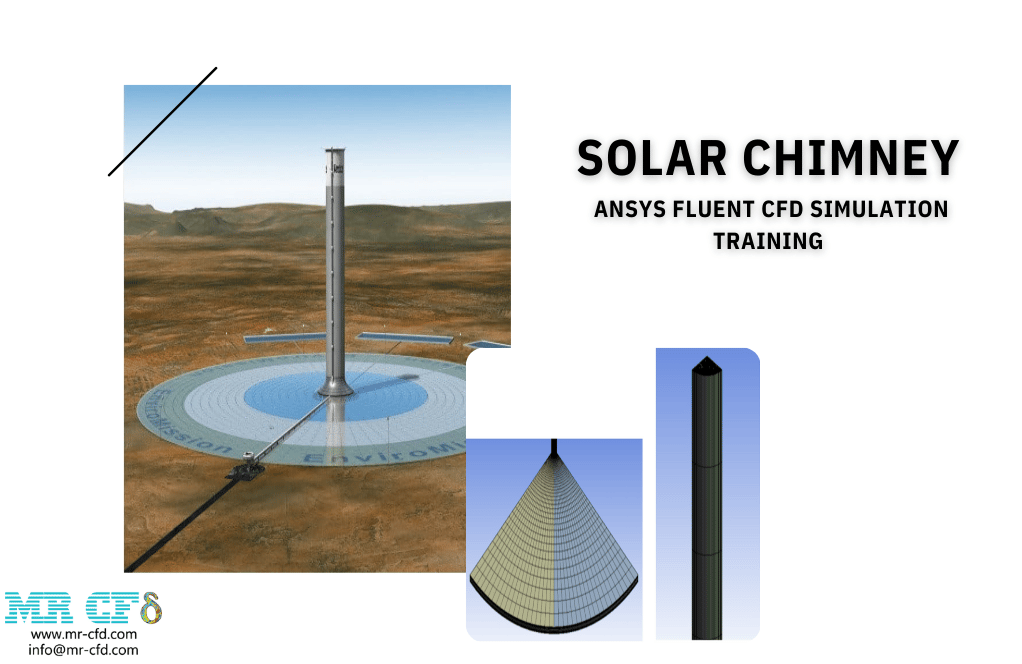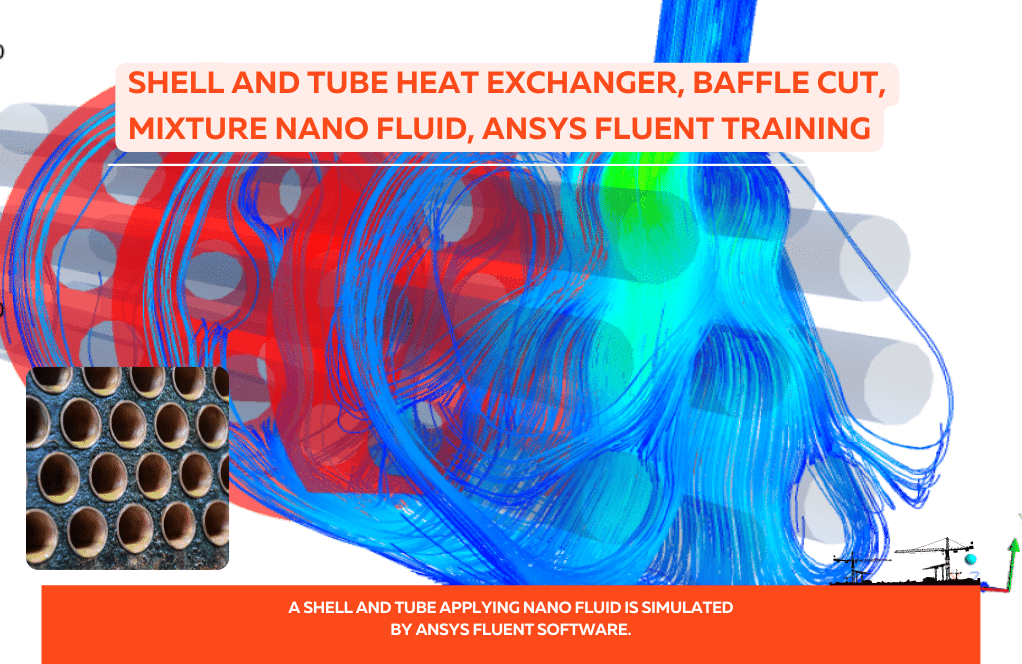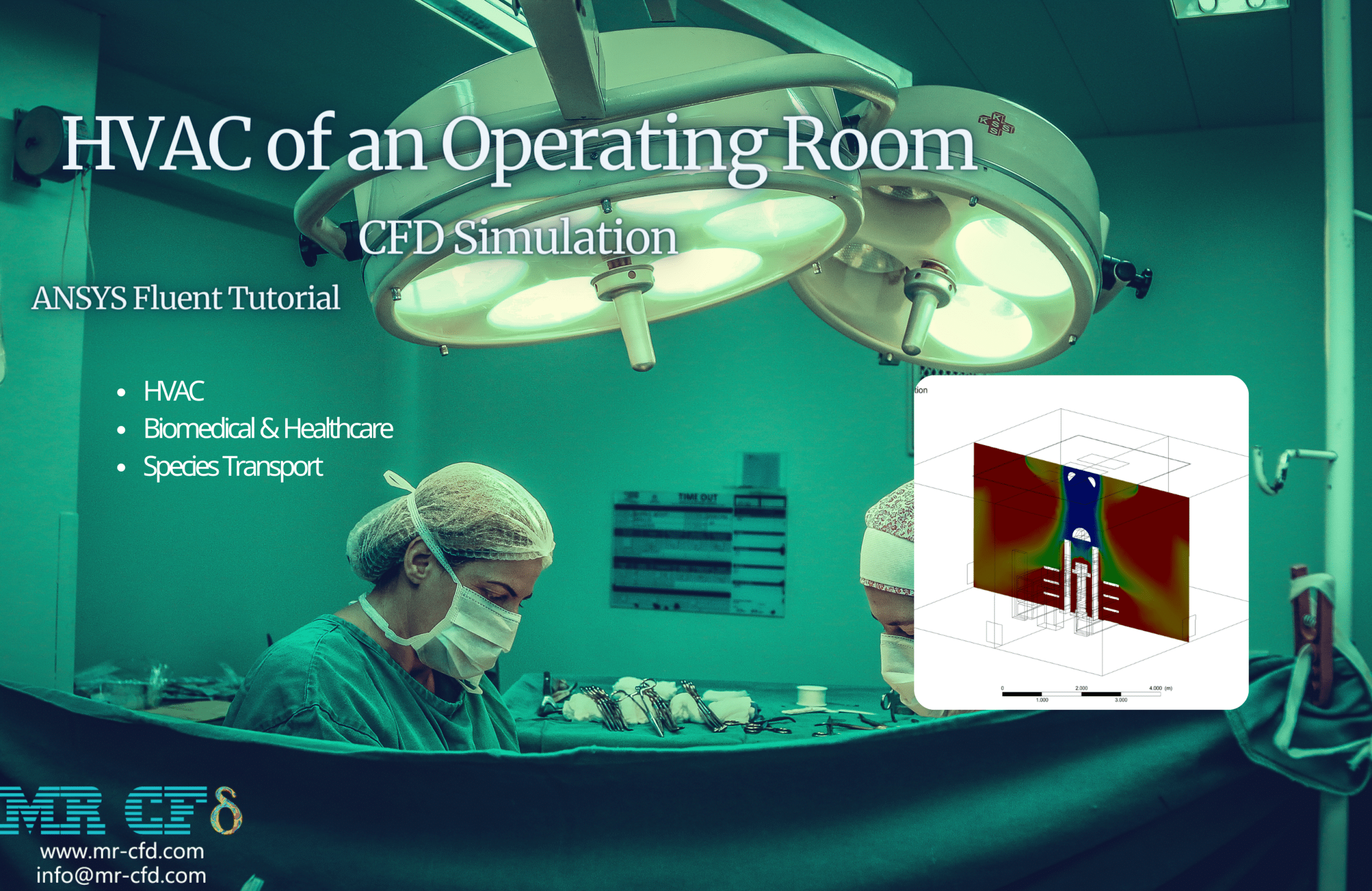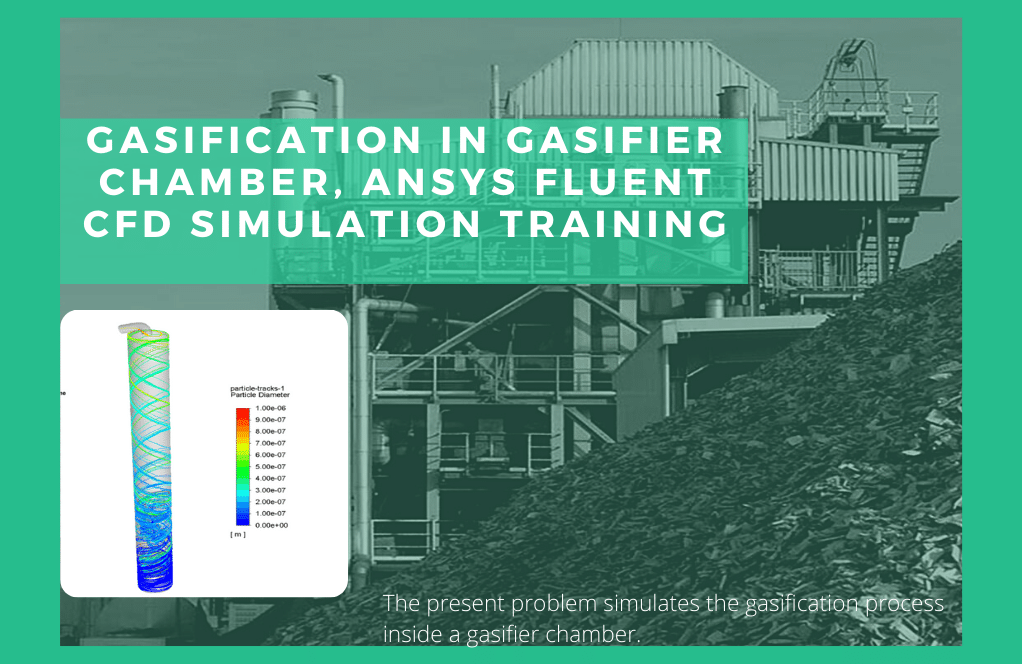Solar Chimney ANSYS Fluent CFD Simulation Training
$80.00 Student Discount
- In this project, we have simulated a solar chimney using ANSYS Fluent software.
- air suck upward to the top of the chimney due to the buoyancy force, thereby discharging warm air through the chimney.
- Three-dimensional solar chimney modeling was done using Design Modeler software.
- The meshing is carried out by ANSYS Meshing software. The mesh type is a structured type, and the element number equals 106323.
- We have activated the energy equation to consider heat transfer in this simulation.
To Order Your Project or benefit from a CFD consultation, contact our experts via email ([email protected]), online support tab, or WhatsApp at +44 7443 197273.
There are some Free Products to check our service quality.
If you want the training video in another language instead of English, ask it via [email protected] after you buy the product.
Description
Solar Chimney Introduction
Today, due to the challenges of fossil fuel consumption, such as increasing air pollution, greenhouse gas emissions, and limited resources, the world is using renewable energies such as solar, water waves, hydro-static, wind, and ground energy. One way to utilize solar energy is the solar chimney.
The basis for a solar chimney is the difference in density and pressure difference due to the increase in temperature inside the solar collectors, which acts as a force. Solar energy is one of the cleanest and most accessible sources of electricity, especially in areas with high annual solar radiation.
In a solar chimney system, there is a transparent roof capable of absorbing solar radiation energy. On the other hand, the air entering the system from the sides of this roof collects in the space between the roof and the ground; in fact, the transparent roof and the ground appear as a collector.
The heat received by the ceilings of the solar chimney heats the air in this space and moves upwards due to its lightness (buoyancy effect). In the middle of this roof, there is a vertical chimney or tower, which due to the difference in pressure between the hot airflow and the cold air, causes the hot air to rise into the upper part of the chimney.
Generally, we can divide these solar chimneys into two categories:
- The first category is the chimneys for power generation, which are of the industrial scale.
- The second category is the ventilation chimneys for cooling and heating used on a residential scale.
Description
In this project, we have simulated a solar chimney using ANSYS Fluent software. The lower part of the chimney is a plate to absorb the heat of the solar radiation, which we assume as a constant temperature in the present simulation. The ground floor below this chimney also has a constant temperature.
The chimney wall is adiabatic to prevent heat loss. The inlet section below the absorber surface has a pressure equal to the atmospheric pressure, while the pressure in the outlet of the chimney is lower than the atmospheric pressure. This causes the air to suck upward to the top of the chimney due to the buoyancy force, thereby discharging warm air through the chimney.
We model the three-dimensional solar chimney modeling using Design Modeler software. We carry out the meshing by ANSYS Meshing software. The mesh is of a structured type, and the element number equals 106323.
Methodology
We have activated the energy equation to consider heat transfer in this simulation.
Solar Chimney Result
As the solar absorber panels increase the air temperature, it becomes lighter, and its density decreases; this causes a pressure drop and suction for upward flow.








Amanda VonRueden –
I am impressed by your CFD simulation products. They look very professional and high-quality. How long does it take to run a simulation and get the results? What kind of software and hardware do you use?
MR CFD Support –
Thank you for your compliment. We are proud of our CFD simulation products and their quality. The time it takes to run a simulation and get the results depends on the complexity of the problem, the size of the domain, the number of elements, and the convergence criteria. On average, it takes about an hour to run a simulation and get the results. We use ANSYS software suite, which includes Design Modeler, SpaceClaim, ANSYS Meshing, ANSYS Fluent, CFX, Mechanical, Workbench, etc., to create, solve, and analyze our CFD simulation products. We also use powerful hardware, such as Intel Core i9 processors, NVIDIA GeForce RTX graphics cards, 128GB RAM, etc., to speed up the computation process.
Michaela Stokes –
Great work! Thank you so much
Glenda Gorczany –
Excellent, thank you and dear colleagues
Kiley Weber –
This is awesome! I have always wanted to learn more about solar chimney and how it works. Your website is very clear and easy to follow. I especially like the contours and vectors that show the temperature and velocity distributions.
MR CFD Support –
Thank you for your appreciation. We are happy that you enjoyed our website and learned more about solar chimney. We try to make our website as clear and easy to follow as possible, using animations and graphs to illustrate the physics and the results of our CFD simulation products.
Rosanna Morar –
This is very cool! I have never seen such a detailed and realistic CFD simulation of solar chimney before. How do you account for the turbulence, radiation, heat transfer, and other phenomena that occur in the solar chimney? What kind of models and boundary conditions do you use?
MR CFD Support –
Thank you for your interest. We are glad that you liked our CFD simulation of solar chimney. We account for the turbulence, radiation, heat transfer, and other phenomena that occur in the solar chimney by using appropriate models and boundary conditions. For example, we use k-epsilon model for turbulence modeling, discrete ordinates model for radiation modeling, conjugate heat transfer model for heat transfer modeling, etc. We also use realistic boundary conditions, such as solar irradiation, ambient temperature, pressure outlet, mass flow inlet, etc., to simulate the actual operating conditions of the solar chimney.
Mr. Mark Armstrong –
this is amazing! I love how you explained the physics and the benefits of solar chimney. This is very helpful for my research project. Thank you for sharing your expertise!
MR CFD Support –
Thank you for your kind words. We are glad that you found our website useful and informative. We hope that our CFD simulation products can help you with your research project. If you have any questions or feedback, please feel free to contact us.
Patience Tillman MD –
Hi, I am interested in buying your CFD simulation products, but I have a question. How do you validate the accuracy and reliability of your results? Do you compare them with experimental data or other numerical methods?
MR CFD Support –
Hi, thank you for your interest in our CFD simulation products. We are able to validate our results by comparing them with experimental data and different numerical methods, to ensure the consistency and robustness of our solutions. We are confident that our CFD simulation products can provide you with accurate and reliable results.
Ms. Lucy Spinka V –
This training really illuminated the complex process of solar chimney simulation for me. The energy transfer within the system and its interaction with the airflow were demystified wonderfully—great job on creating such a clear and comprehensive training package!
MR CFD Support –
Thank you for your positive feedback! We’re thrilled to hear that our Solar Chimney ANSYS Fluent CFD Simulation Training helped demystify the concept and brought a clear understanding of the energy interactions. Our team is dedicated to providing comprehensive educational materials, and it’s rewarding to know that this product contributed to your learning. Stay tuned for more insightful training modules!
Moses Brekke –
I am delighted with how the Solar Chimney ANSYS Fluent CFD Simulation Training illustrates the utilization of solar energy. It’s impressive and very relevant to current energy needs!
MR CFD Support –
Thank you for your kind words. We’re thrilled to hear you’re satisfied with the Solar Chimney Training! It’s fantastic to see our customers engaged and finding value in our products, especially regarding such an essential subject as renewable energy. If you have any more feedback or require further assistance, please don’t hesitate to reach out.
Miss Teagan Ernser IV –
I recently used the solar chimney simulation training package by MR CFD and found it to be incredibly insightful. The material was well-structured, and it really enhanced my understanding of how solar chimneys work and how they can be modeled using ANSYS Fluent.
MR CFD Support –
We’re glad to hear you found our solar chimney simulation training package helpful and informative. It’s fantastic to learn that our content could enhance your understanding of solar energy applications and simulation modeling. Thank you for choosing MR CFD, and we appreciate you taking the time to share your positive experience! If you have any further questions or need assistance with other simulations, feel free to reach out.
Mr. Antonio Gerlach –
Fantastic learning resource on solar chimney simulation. The methodology is well laid out and the application of theory to practical modeling is superb. The structured mesh and detailed approach to buoyancy and pressure differences showcase a real-world scenario which is essential for understanding and training purposes. I especially appreciated the depiction of how natural principles like buoyancy are used in innovative energy solutions.
MR CFD Support –
Thank you so much for your kind words and positive feedback on our Solar Chimney ANSYS Fluent CFD Simulation Training. We’re glad to hear that our product met your expectations and provided you with valuable insights into solar energy utilization. Continued exploration and learning lead to innovation, and we are thrilled to be part of your educational journey.
Prof. Kara Rutherford –
The layout and information has given me a great understanding of how solar chimneys work! The simulation mix of energy and buoyancy-driven airflow seems quite complex, but elegantly executed in ANSYS Fluent. Did your team face any particular challenges while modeling the temperature variations and energy absorption?
MR CFD Support –
Thank you for your lovely feedback! We pay careful attention to modeling temperature gradients and energy absorption as they are critical to the accuracy of a solar chimney simulation. We do encounter challenges, such as ensuring that the heat transfer is accurately modeled and that the buoyancy effects are realistically represented. Our team uses calibrated models and validated boundary conditions to overcome these challenges and provide the most realistic results possible.
Lauretta Effertz –
I thoroughly enjoyed learning to simulate a solar chimney using the ANSYS Fluent course. The visual aids were particularly helpful in understanding how solar energy can be harnessed, and the detailed step-by-step explanation made the complex physics behind this technology much more approachable.
MR CFD Support –
Thank you so much for your kind words! We’re thrilled to hear that our ANSYS Fluent Solar Chimney simulation course was informative and easy to follow. It’s great to know our efforts to create clear visual aids and step-by-step guidance are making the learning experience better for our users. Your feedback is highly appreciated!
Mr. Maverick Heathcote –
I’m amazed at the realistic nature of this ANSYS Fluent CFD simulation for the solar chimney. The detail on heat absorption and the use of buoyancy to mimic airflow is impressive. It’s encouraging to see such advanced use of CFD for renewable energy applications.
MR CFD Support –
Thank you for your kind words! We are delighted to hear that you are impressed by the level of detail and realism in our ANSYS Fluent CFD simulation for the solar chimney. It’s our goal to provide high-quality simulations that are both informative and useful for advancing renewable energy technology. We greatly appreciate your encouragement and support!
Ebba Schaden –
I was truly impressed with the innovative design of the solar chimney simulation — the attention to detail really made the difference! The use of renewable solar energy is not only fascinating but environmentally beneficial, and the training provided by MR CFD showed that exceptionally well. Will definitely look to participate in more simulations to expand my knowledge on sustainable energy CJ, educational, technologies!
MR CFD Support –
Thank you for your kind words! We’re glad to hear that our Solar Chimney ANSYS Fluent CFD Simulation Training exceeded your expectations and provided insightful knowledge on renewable energy technologies. Your enthusiasm for learning is truly inspiring, and we look forward to assisting you in further expanding your skills in sustainable energy. Keep an eye out for more of our trainings!
Peggie Koelpin II –
I have learned a great amount from the Solar Chimney ANSYS Fluent CFD Simulation Training. It provided a detailed understanding of setting up and solving a CFD problem which represents a real-world application of renewable energy technology. The process from model creation to obtaining results was clearly explained, and the use of the energy equation to take heat transfer into account was fascinating. It’s impressive to see the buoyancy effects simulated and how this relates to the functioning of the solar chimney.
MR CFD Support –
Thank you for your kind words! We’re delighted to hear that you found the Solar Chimney ANSYS Fluent CFD Simulation Training valuable. It’s fulfilling to know that we could effectively convey the setups and results, as well as the real-world implications of this technology. We are passionate about equipping our learners with comprehensive insights into CFD applications, and your satisfaction with the information on renewable energy technologies is greatly appreciated.
Jaleel Bednar MD –
This instructional product was crystal clear! Thanks to MR CFD’s step-by-step approach, I now fully understand how solar chimneys work and how to simulate one using ANSYS Fluent. The explanations on buoyancy effects and the role of solar absorber panels were particularly enlightening.
MR CFD Support –
Thank you so much for your positive feedback. It is great to hear that our training session on the solar chimney simulation in ANSYS Fluent was helpful for understanding the buoyancy effects and the solar absorber panels’ role. We are pleased that our step-by-step approach made the learning process clear. If you have any more questions or need further assistance, please do not hesitate to reach out.
Prof. Edwina Jaskolski IV –
The CFD training for solar chimneys seems very practical in today’s energy landscape. Impressed by the thoroughness in capturing thermal and fluid dynamics for an innovative renewal energy system. Keep up the great work!
MR CFD Support –
Thank you for your kind words! We’re glad to hear that our Solar Chimney ANSYS Fluent CFD Simulation training was helpful and met your expectations. We strive to provide comprehensive and relevant education on renewable energy technologies. Your feedback motivates us to continue creating quality training programs.
Sasha Eichmann –
I recently completed the Solar Chimney ANSYS Fluent CFD Simulation training and was impressed by the clarity of the concepts. The methodology of including energy equations to consider heat transfer and the visualization of air movement due to buoyancy effects were particularly well explained.
MR CFD Support –
Thank you for your feedback! We’re thrilled to hear that the training was clear and informative for you, and that you found the methodology and visualization aspects valuable. We continually strive to provide high-quality learning materials that help our clients understand complex concepts.
Alaina Hoeger –
This product sounds intriguing! The description mentions a set_CONSTANT temperature for simulation—what specific temperature is used for the solar absorber plate in this case?
MR CFD Support –
We’re glad you’re interested! In this simulation scenario, we typically use a temperature value that realistically models the conditions of solar absorber plates. Although the specific temperature used in the tutorial was not mentioned here, such simulations often employ temperatures that simulate peak solar irradiance periods. The chosen temperature would typically correspond to the average peak temperature achievable by solar absorber plates in a given environmental setting.
Drew Denesik –
This training content looks comprehensive! Kudos for including both various renewable energy contexts as well as detailing the functionality of solar chimneys in both industrial and residential applications. It appears quite informative for understanding the principle operation as well as the simulation setup in ANSYS Fluent for such eco-friendly energy systems.
MR CFD Support –
Thank you so much for your positive feedback! We are glad that you found the Solar Chimney ANSYS Fluent simulation training informative and comprehensive. Understanding renewable energy systems is quite crucial, and we take pride in contributing to this sector through our educational content. If you have any more inquiries or need further assistance, don’t hesitate to reach out.
Ms. Angelita Quitzon III –
I love how this simulation captures the renewable energy aspect of the solar chimney! The explanation of how convection works through the collector and up the chimney is fascinating. Has this setup been compared with experimental data to verify its accuracy?
MR CFD Support –
Thank you for your compliment on our solar chimney simulation training. We are pleased you find the method fascinating. While this simulation incorporates detailed physical phenomena and boundary conditions to accurately represent the solar chimney system, any specific comparisons to experimental data to verify accuracy are beyond the scope of the provided information. Our training materials are meant to educate on the setup and analysis in ANSYS Fluent, but we encourage those pursuits in course participants’ independent projects.
Laney Kassulke –
I truly enjoyed learning from the Solar Chimney ANSYS Fluent CFD Simulation Training product. The clear step-by-step methodology and the provided results illustrating temperature-induced air movement were impressive. Great work in creating such an enlightening educational tool for renewable energy systems simulations!
MR CFD Support –
Thank you for your positive feedback on our Solar Chimney ANSYS Fluent CFD Simulation Training! We’re thrilled to hear that the simulation steps and results showcasing the temperature effects were helpful to you. Your encouragement means a lot to us, and we’ll continue to provide quality learning materials. If you need further assistance or have any more questions, feel free to reach out!
Roscoe Macejkovic –
I’m greatly impressed with the infographic-style results in this Solar Chimney simulation! The visualization of temperature and airflow patterns provides clear insight into the functionality of solar chimneys. The flow of air through the chimney was beautifully depicted too. Well done on combining scientific rigor with visual clarity!
MR CFD Support –
Thank you for the kind words about our Solar Chimney ANSYS Fluent CFD Simulation Training product! It’s fantastic to hear that our visualizations delivered a helpful and clear understanding of the solar chimney’s operations. We strive to ensure that our products are both technically accurate and easy to comprehend. Your satisfaction with the clarity of our simulation results is immensely appreciated!
Dr. Madilyn Baumbach –
I’m thrilled with the quality of the training on solar chimney CFD simulation! The course was comprehensive and the results matched the physical phenomena of buoyancy and pressure difference that drive the flow in a solar chimney. Well done!
MR CFD Support –
Thank you very much for your kind words and for taking the time to provide your positive feedback on our Solar Chimney ANSYS Fluent CFD Simulation Training. We’re glad that we could provide valuable insights into the simulation of solar chimneys and that you were satisfied with the training outcomes. We always strive to offer high-quality training that meets our clients’ expectations. If you have any further questions or need additional training, do not hesitate to reach out to us. Your satisfaction is our top priority!